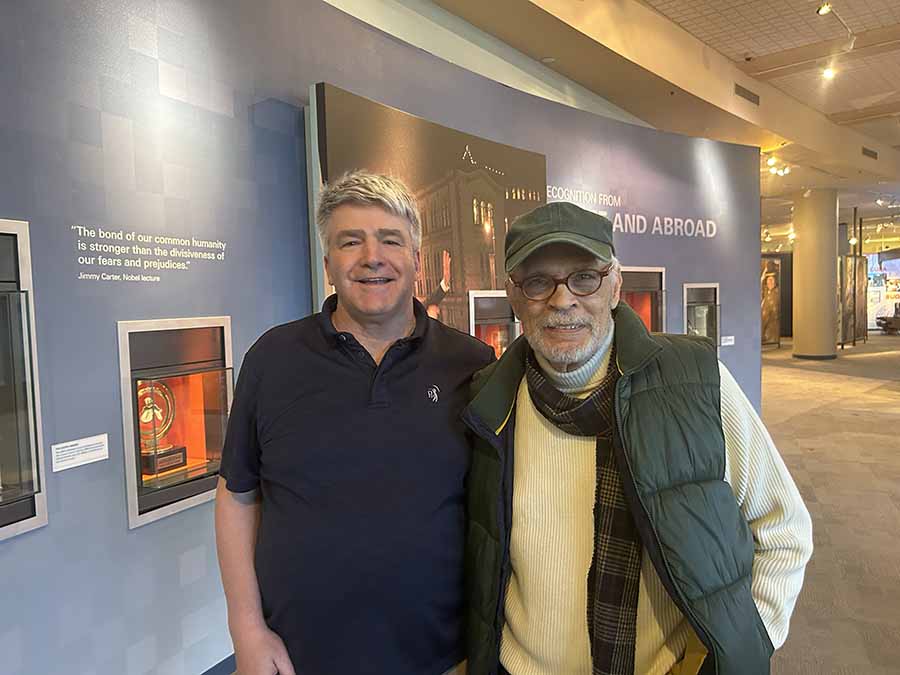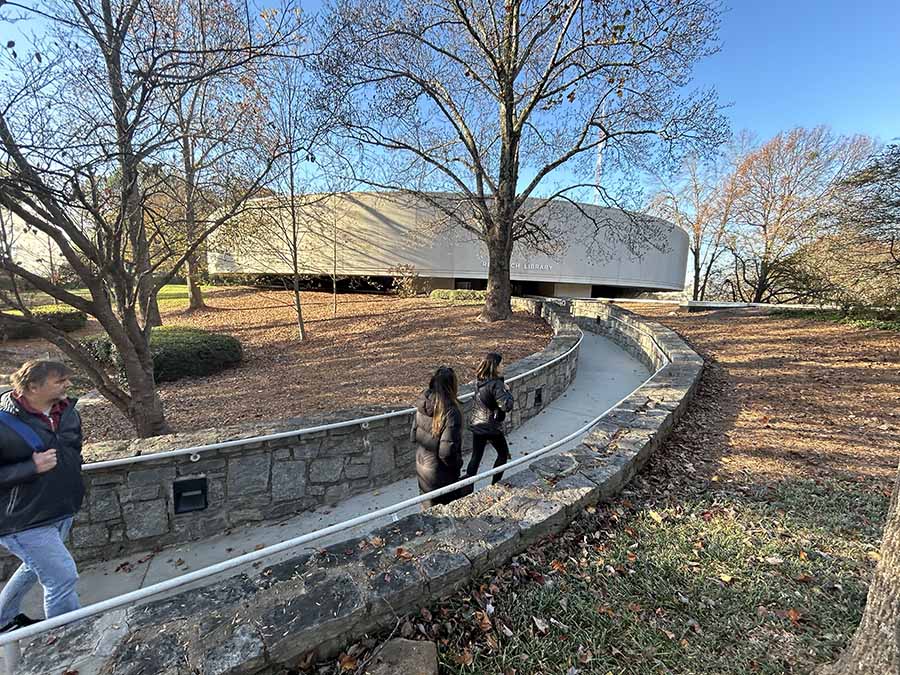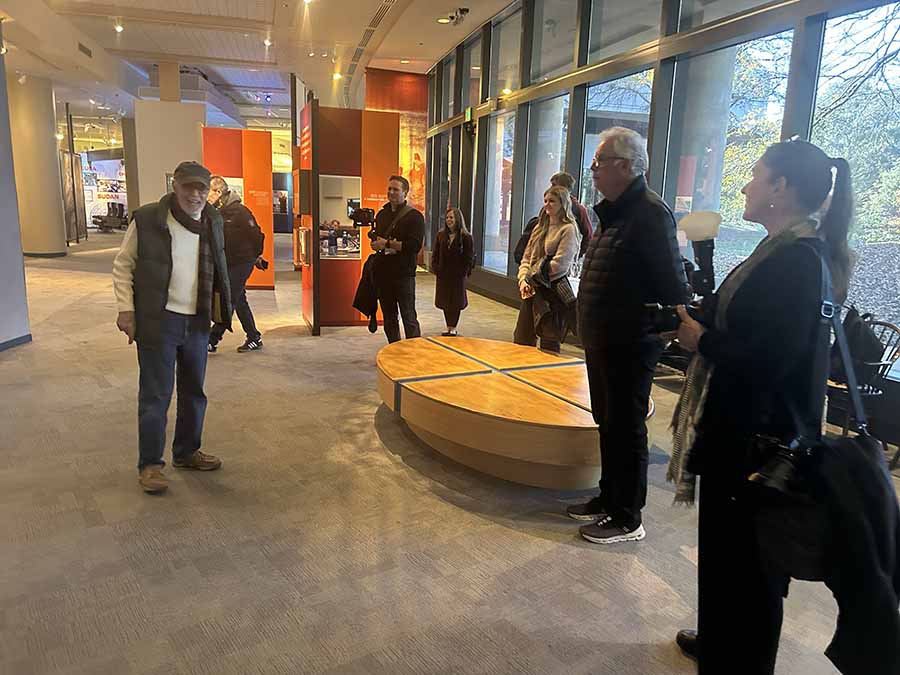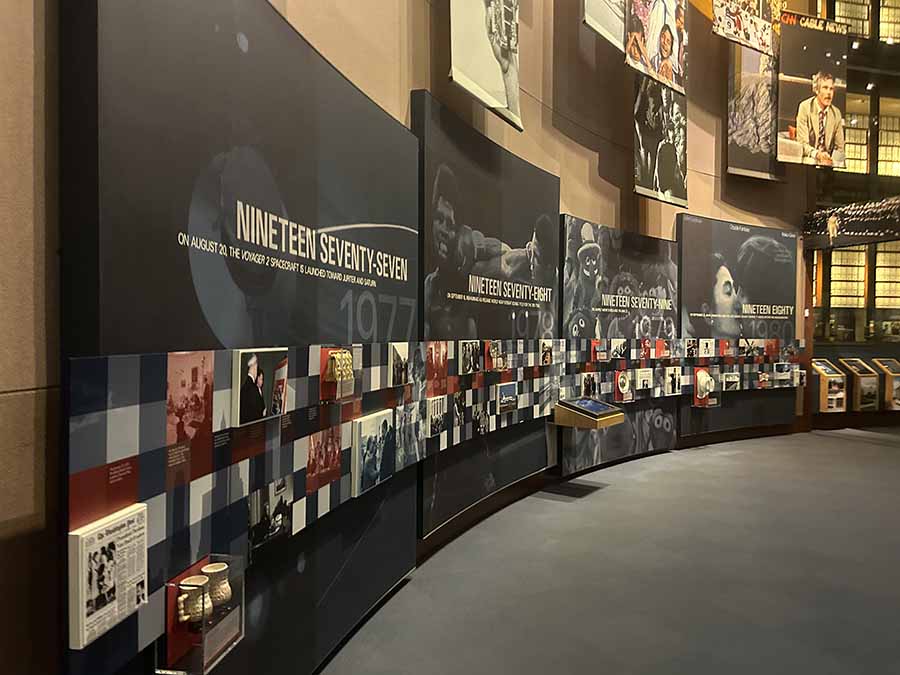Jimmy Carter was an unexpected president. He was virtually unknown outside of his home state in Georgia when he started campaigning in 1976. Without a political machine, he sent clusters of neighbours and family members to the various primary battlefields, and used of his limited resources to great effect in a way that was new to presidential political campaigns but has since become the norm. According to Chip Carter, at one stage eleven family members were in eleven different states.
His story of growing up in segregated Georgia, his role in the civil rights movement and his stellar rise to the top of American politics is told in the Atlanta Jimmy Carter presidential centre. From his inaugural address as governor of Georgia: “I say to you quite frankly that the time for racial discrimination is over. The test of a government is not how popular it is with the powerful and privileged few, but how honestly and fairly it deals with the many who must depend upon it.”
We were accompanied on our journey by tour guide Tony Clarke, a former journalist with CNN and long standing personal friend of the president.
His observations, storyboarded to accompany the big achievements of Carter’s presidency resonate to this day: the historic Camp David deal between Israel and Egypt is accompanied with his quote: “After four wars, despite vast human efforts, the Holy Lands does not enjoy the blessing of peace.”
And how unexpectedly prescient is the story of how he negotiated the Panama Canal treaty, “there is NO Panama canal, there is an American canal in Panama,” and “the Panamanians feel the same about the Panama canal as North Americans would feel if the British owned the Mississippi river.
In 1977 he observed We fought fire with fire, never thinking that fire is better quenched with water. His work in Africa for which he won the 2002 Nobel Prize, is documented in detail.
‘The bond of our common humanity is stronger than the divisiveness of our fears and prejudice.”
Carter’s wisdom will outlive him. Although you do not have to travel to Atlanta to find it, the journey is well worthwhile.
- The Museum of the Jimmy Carter Library in Atlanta offers visitors an immersive experience showcasing the modern American presidency through engaging exhibitions of artifacts, documents, and multimedia presentations.
- Highlights include the “Day in the Life of the President” feature, a life-size replica of the Oval Office, and an interactive Map Table that enhances the understanding of key historical events such as the Camp David Meetings.
- The library and museum are situated on 30 acres of picturesque parkland between two lakes, providing a serene environment with views of the Atlanta skyline.
- Admission to the museum is $12, and it operates Monday to Saturday from 9:30 a.m. to 4:30 p.m., making it accessible for family visits and educational outings.
- Delta flies daily to Atlanta using a B763, flight time is 9 hours 25 minutes and fares start from €330 return.


Tony Clarke’s tour
There are two different aspects to the Carter Center. From the bottom of the stairs, all the way around to the other side is the Carter Center, the nonprofit organization that President and Mrs. Carter started to work on democracy, health, and other post-presidency initiatives. We’re part of the federal government and the National Archives and Records Administration, functioning as the library and museum. While we’re separate entities, we work well together. Our job is to preserve the past and make it accessible to the public, while the Carter Center focuses on the future and improving lives.
The site is also historic; during the American Civil War, this was the Augustus Plantation. General Sherman used this location as his headquarters during the Battle of Atlanta due to its high ground. From here, he led the Union troops to Savannah, bringing an end to the Civil War.
The original museum was built in 1986, but in 2009, we renovated it to better tell the story of President and Mrs. Carter. Carter was born in 1924, just before the Depression, attended the Naval Academy during World War II, and was deeply influenced by the Civil Rights Movement.
We have an interesting item from his baby book, his birth record. His parents named him James but intended to call him Jimmy. Mrs. Carter once told me no one ever called him Jim.
President Carter is the oldest living president, having outlived every other president since Thomas Jefferson. He has spent more years post-presidency than anyone else. Despite his age and health challenges, he remains alert.
I joined in 2004, right before his 80th birthday. The Carters frequently traveled to Africa and other places, showing incredible energy. They would spend a few days each month here in meetings, and I had the chance to meet various notable people through their visits.
Jason, their grandson, likes to point out Carter’s high school picture, highlighting that anyone can make a difference. Mrs. Carter was big on mental health and established a journalism fellowship to focus on mental health issues.
The museum section tells why Carter is the way he is. He grew up in a segregated area, with most of his friends and neighbors being African American. His father was a segregationist, but his mother was a nurse who treated everyone equally. This upbringing influenced his lifelong work on human rights.
Carter’s early experiences with segregation and his mother’s compassionate nature inspired his dedication to human rights. A significant figure in his life was Bishop Johnson, who had to honk his horn for Carter’s father to come out, as he wasn’t allowed in through the front door. His mother, however, invited everyone in, showing her inclusive nature.
Carter’s mother, being a nurse, often left notes for the family on a table they called “Mother” due to her frequent absences. His father spent a lot of time with the people on the farm, and Carter often stayed with Jack and Rachel Clark when his parents were away, learning about kindness and respect from them.
The people who influenced him, aside from his family, include this lady over here, Julia Coleman, a school teacher who encouraged him to read. She had a programme where he read 26 books one summer.
She kind of looks like Judy Garland from “The Wizard of Oz,” but more like Little Debbie from the snack cakes. She was so happy to get married, but seven years after they got married, his dad died. He decided to leave the Navy, go back to Plains, and take over the family business. She was not happy at all. She wrote in one of her books, “I cried, I screamed, and we argued. I thought the best part of my life was over.” She refused to talk to him on the drive back to Plains. If they had anything to say to each other, it was always through their children. But once she got back to Plains, she knew the business better than he did and ended up loving being there with the kids.
Religion was a significant part of everything he did. He got close to Martin Luther King’s family, even though he didn’t know King personally. He hadn’t planned on getting into politics, but a candidate for governor wanted to shut down schools rather than integrate them. So, Carter ran for the state senate, lost due to election fraud, but didn’t concede. He went to court, won, and served two terms in the state senate. He ran for governor, lost, ran again, and won. In his inaugural address, he declared, “The time for racial discrimination is over.”
During a previous administration, he emphasized the importance of honesty. He decided to run for president, campaigning with friends and neighbors due to a lack of funds. Winning in Iowa and New Hampshire made him a viable candidate. He used bands like the Allman Brothers and Bob Dylan to attract young voters.
He had a tough race against Vice President Humphrey, segregationist George Wallace, and others. He campaigned on the promise of never lying to the American people. A reporter once asked his mother if he ever lied, and she said, “Maybe a white lie.” When asked what a white lie was, she replied, “When you came to the door and I said I was pleased to have you here, that’s a white lie.”
Carter is the reason we have presidential debates again. The first debate was Kennedy-Nixon, then they stopped until Carter’s time. He won the presidency, and his inauguration included notable figures like President Ford, Vice President Mondale, Coretta Scott King, and Shirley Temple Black.
Amy, his daughter, was reading a book during his inaugural address. They walked down Pennsylvania Avenue with his family, including his son Jason, now head of the Carter Center Board of Trustees.
Jerry Parr, the Secret Service agent who later saved Reagan’s life, was there. Carter’s coat during the campaign was borrowed from his media advisor, Jerry Rafshoon, and never returned. Mrs. Carter wore the same dress for both inaugurations, which caught the attention of the fashion police.
The Oval Office replica is an exact size, with most items being reproductions. The desk is a copy of the famous Resolute Desk, made from wood from the British ship Resolute, given to the U.S. by Queen Victoria as a gesture of goodwill.
Kennedy was the first president to use it in the Oval Office, and it became famous when his son played hide and seek, opened the latch, and stuck his head out, with a photographer capturing the moment. It has become the most popular desk used in the Oval Office. Carter used it, Reagan used it, Bush used it, Obama used it, Trump used it, and Biden uses it. But when you’re president, you can use any desk. The most prestigious area is the Oval Office.
These are all things Carter faced coming into office. We’ve been through the Vietnam War. One of his first things was to end the draft. We had been through Watergate, international terrorism, the Munich Olympics, and the Cold War was very much underway.
In the middle is a day in the life we follow through a single day. You can follow the president through a single day, and what’s interesting about it is all the things that he dealt with that are still being dealt with, like immigration, immunization, and efficient cars. The other couple of things, there are some pictures of life in the White House. Amy is still reading the book.







